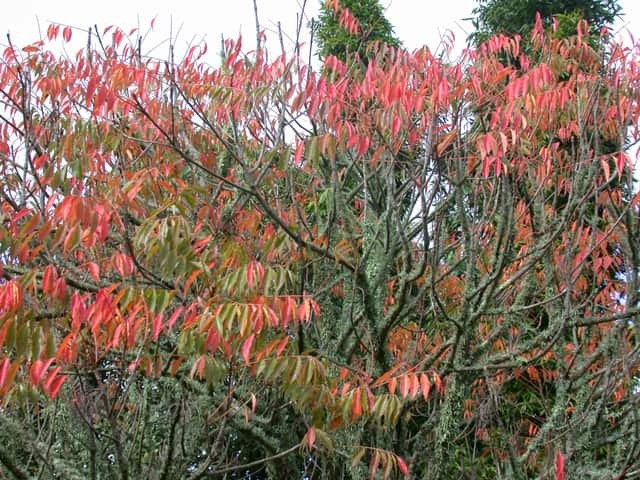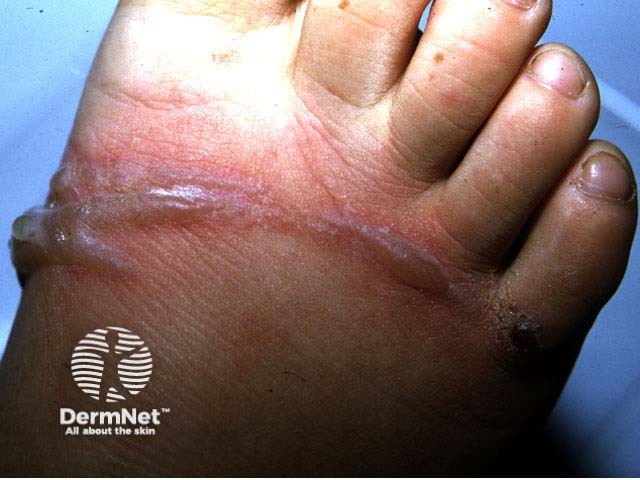Main menu
Common skin conditions

NEWS
Join DermNet PRO
Read more
Quick links
Rhus tree — extra information
Common name: |
Rhus, rhus tree, Japanese wax tree (not the Japanese lacquer tree), scarlet rhus, sumac, wax tree. |
|
Botanical name: |
Toxicodendron succedaneum |
|
Family: |
Anacardiaceae |
|
Origin: |
There are 15 species of Toxicodendron native to China, at least 8 to Malaysia/Indonesia, and 6 to the Western hemisphere, although they have been introduced elsewhere as exotics |
|
Description: |
Most Toxicodendron are small trees, shrubs or vines with compound leaves, the exception being T. borneense which has simple leaves. The flowers are generally asexual with 5 sepals (or calyx lobes), five petals, and five stamens. The ovary has 1 locule, with a short style and three stigmas. All produce the skin-irritating oil urushiol, which can cause a severe allergic reaction; hence the scientific name which means ‘poison tree’. The main species of Toxicodendron to cause dermatological problems are T. radicans (poison ivy) and T. diversilobum (poison oak) which, with their various subspecies, are found predominantly in Northern America. In the Southern Pacific, the three main allergenic toxicodendron are T. striatum, T. succedaneum, and T. vernicifluum. Toxicodendron succedaneum is a large shrub or tree, up to 8 m tall, somewhat similar to a sumac tree. The leaves turn orange, red or scarlet in autumn. Small, yellow flowers are followed by pendulous clusters of tawny fruit. |
|

Rhus aromatica

Toxicodendron
Uses: |
An ornamental garden tree. In Japan, the tree is cultivated for the fruits from which a wax (sumach wax) is extracted for use in varnishes, polishes, ointments, and plasters. |
|
Allergens: |
Urushiol; 3-heptadec(en)yl catechol. |
|
Allergy: |
Toxicodendron species contain oleoresins known collectively as urushiol. In susceptible individuals, these compounds trigger a type IV delayed hypersensitivity reaction, a bullous allergic contact dermatitis. Toxicodendron dermatitis is the most common cause of contact dermatitis in the United States, exceeding all other causes combined (usually due to contact with Poison Ivy (Toxicodendron radicans) or Poison Oak (Toxicodendron diversilobum). |
|
Toxicodendron dermatitis

Toxicodendron dermatitis

Plant dermatitis
Cross reactions: |
Anarcardaceae (mango, cashew, Japanese lacquer, Indian marking nut, and African poison ivy). Interestingly there are also several genera of unrelated families such as ginkgo and grevillea which, may cross-react with Toxicodendron spp. |
|
Other information: |
||
Patch test: |
Discouraged because of risk of sensitisation. |
|
References
- Aplin, T. E., Plants that cause dermatitis, Australas J Dermatol, 22, 33, 1981.
- Botanical Dermatology Database. http://www.botanical-dermatology-database.info/
- Cardinali C, Francalanci S, Giomi B, et al: Contact dermatitis from Rhus toxicodendron in a homeopathic remedy. J Am Acad Dermatol 2004 Jan; 50(1): 150-1
- Chapel TA, Chapel J: Toxicodendron Dermatitis. Emergency Medicine - A Comprehensive Study Guide. 4th ed. 1996: 1111-1113.
- Connor, H. E., The Poisonous Plants of New Zealand, 2nd Ed, Government Printer, Wellington, 1977.
- Cook, D.K., Freeman, S., Allergic contact dermatitis to plants: an analysis of 68 patients tested at the Skin and Cancer Foundation, Australas J Dermatol, 38, 129, 1997.
- Mitchell JC, Rook A, 1979, Botanical Dermatology, Plants and Plant products injurious to the skin, Greengrass, Vancouver.
- Nakamura, T., Contact dermatitis to Rhus succedanea , Contact Dermatitis, 12, 279, 1985.
- Oh SH, Haw CR, Lee MH: Clinical and immunologic features of systemic contact dermatitis from ingestion of Rhus (Toxicodendron). Contact Dermatitis 2003 May; 48(5): 251-4
- Rademaker, M., Duffill, M. B., Allergic contact dermatitis to Toxicodendron succedaneum (Rhus trees) - an autumn epidemic, NZ Med J, 108, 121, 1995.
- Rademaker, M., Duffill, M. B., Toxicodendron succedaneum (Rhus tree), New Zealand's poison ivy, Contact Dermatitis, 33, 357, 1995.
- Wooldridge WE: Acute allergic contact dermatitis. How to manage severe cases. Postgrad Med 1990 Mar; 87(4): 221-4
Other websites
- Poison Ivy, Oak and Sumac– Medline Plus
- Poison Ivy, Oak and Sumac – emedicine consumer health
